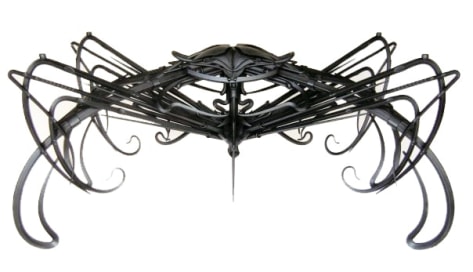
John Haley III, a rising star among American metalsmiths, started his professional life as an artist with a vision. Like Roy Neary, the Richard Dreyfus character in the 1977 movie Close Encounters, Haley was obsessed with a pointy shape that recurred in his dreams and his work. Throughout the late 1980s and early ‘90s, as he drew and painted, produced video art and made collages using photocopied images, the mysterious anvil-like form haunted him. Meanwhile, with a father who was a rocket scientist, Haley’s mind often wandered to space travel. In fact in 1991, during a serious manic episode, he came to believe that he was from the planet Saturn.
Between jobs in 1993, Haley returned to his hometown (Evergreen, Colorado). He answered an ad placed in the local newspaper by a blacksmith in need of an apprentice. It was when he arrived for the interview that a large anvil brought his vision and future into sharp focus. It was the shape he’d been dreaming of; his destiny was clear. He signed on immediately even though the rate of pay was a rock bottom $4.00 per hour. For three years he learned the rudiments of steel-smithing and then set out to develop artistry on his own.
Haley says that he always favored spirals, arabesques, and organic shapes in his work. He continued the theme with his forged steel pieces, discovering as his tastes matured that Parisian fin de siècle designer Hector Guimard had set the bar high in the organically-shaped-metal arena nine decades earlier. Although Guimard became his professional idol, Haley’s work is clearly his own. Wrought steel rather than cast iron, it is more densely composed, more textural, and a great deal more jagged in profile than Guimard’s gentle forms. In addition, because most of Guimard’s work was designed for architectural commissions and cast in a foundry, it was precisely planned and employed repetitive motifs. Haley’s work, by contrast, is spontaneous and one of a kind. Although he draws general plans for his larger pieces, he takes advantage of serendipitous events, allowing for differences even in the two halves of a single, more or less symmetrical piece.
In his smaller pieces, Haley allows his imagination and subconscious free reign. “By cutting elements in the ratio of the Golden Mean and consistent with my preference for flowing organic shapes, everything just seems to fit together,” he says. “And if it doesn’t, I just make the necessary adjustments. I’m aware of the skull-like lines of some of my pieces and the sexual connotations too, but it’s not something I plan.”
Developing in the era of real and imaginary space travel, exposed to the destructive power of long range missiles and close range weapons, influenced by a wide range of environmental threats, Haley’s subconscious often delivers menacing messages… particularly when the metal retains it natural black or gray color. But his recent experiments with green-brown patinas have yielded more subtle results. While some of his black table bases resemble evil farm equipment, in green the spikes become twigs, the springs become tendrils, and the jagged plates become plump juicy leaves.
Always open to the happy accident, Haley came upon the idea of patinating shaped-wood table tops when he pried a piece of painted wood off of his work table. “The blotchiness of the side that was stuck to the table appealed to me,” he explains. “I experimented with various methods to get the texture that would compliment the metal.” He also uses glass tops because they contrast nicely with the metal and allow the sculptural quality of the base to be seen from all sides. But recently a client requested a thick concrete top for a commissioned demi-lune table. Haley was open to the idea of change and was pleased with the result.
In October 2008, the Jason Jacques Gallery featured Haley’s work as a compliment to their collection of early 20th century European art pottery at the International Art + Design Fair, held at New York’s Park Avenue Armory. Critics and the general public responded enthusiastically, placing orders that will keep the smith busy for at least a year. “I may even be able to hire an apprentice,” he says. “It would be nice to have someone younger doing the grunt work.” Now in his early 40s, Haley is hardly old but forging hot steel is punishing labor. Meanwhile, he runs a one-man shop and spends free time with his wife and two teenagers. Describing himself as bipolar, Haley believes that his art is a pure expression of his subconscious. It is the ability to express deeply held thoughts, beliefs and opinions through finely wrought materials that elevates craft to art and there is no doubt that Haley is both a fine craftsman and a fine artist.